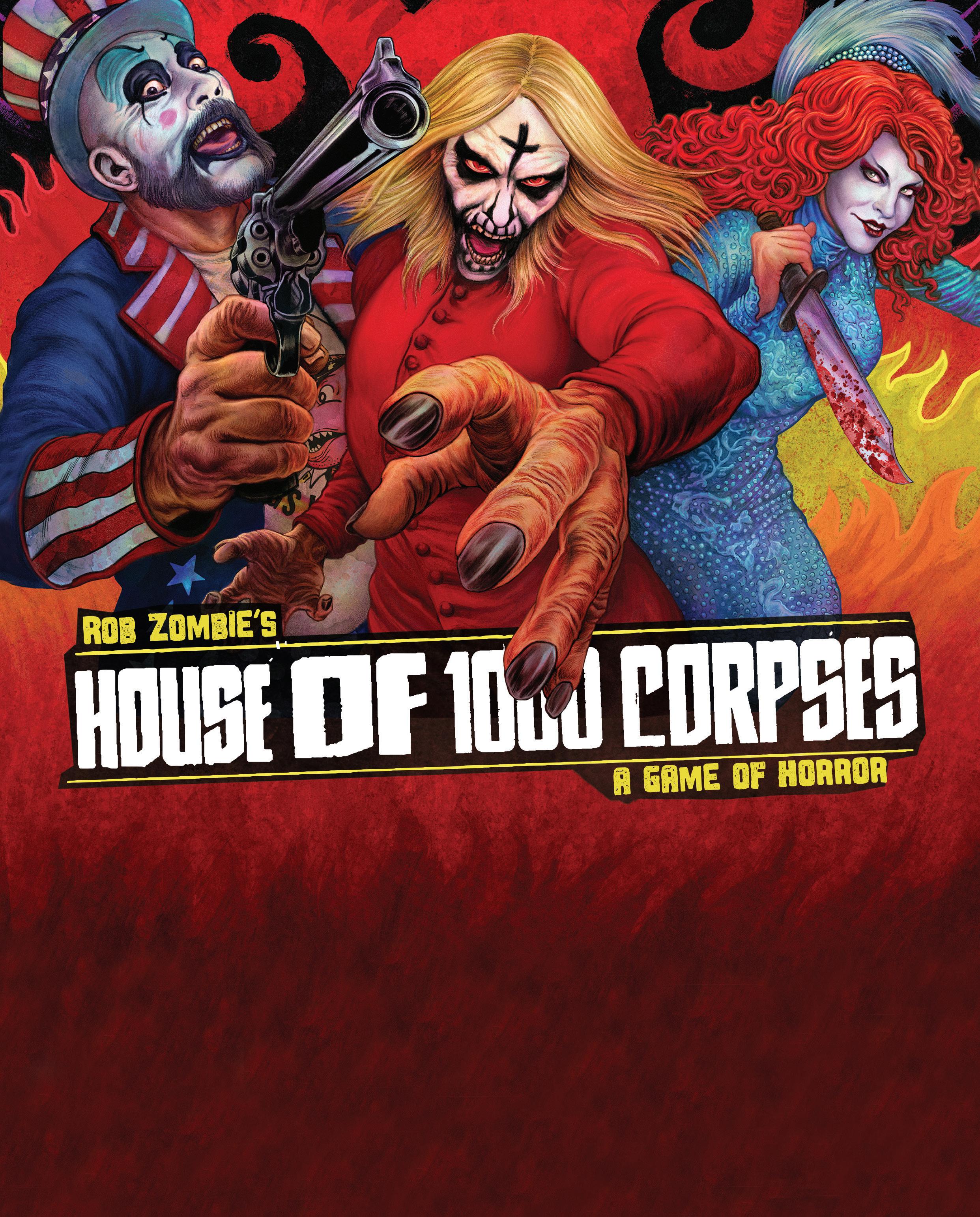
1-4 PLAYERS • 60 MINUTES • AGES 17+
A Game
by Nick Badagliacca
“They all run like scared little rabbits…run, rabbit, run!”
It’s Halloween Eve, 1977. You and up to 3 fellow players are the Firefly family: a bizarre, murderous brood of psychopaths occupying a decrepit house deep in the backwoods of Ruggsville, Texas. Hidden within the Firefly homestead are several victims desperately running for their lives as the players work cooperatively to dispatch them. But Ruggsville Sheriff ’s Lt. George Wydell has picked up your trail and backup is on the way! You’ll need to work quickly…
Hunt down as many victims as possible, choosing their grisly fate as you and the other players work to fill your Blood Meter. Will you kill them yourselves, leaving gruesome, mutilated corpses behind? Or will you capture and deliver them to local legend Doctor Satan: murderer, torturer, but most of all… master surgeon. If the Fireflys can fill their Blood Meter before Captain Spaulding’s Murder Ride is over, they will win the game together as a family. But if too many victims escape the house or the cops spoil the fun, they will all lose instead!
Any time this year folks! The tour is about to begin. This is the house…come on in!
1

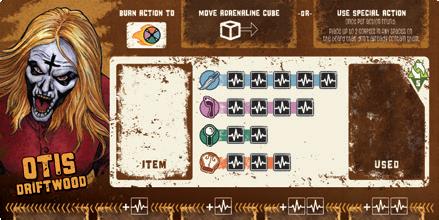
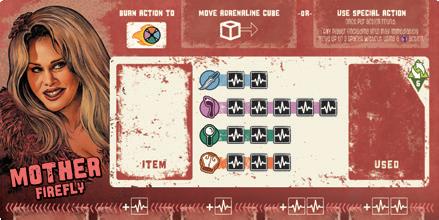
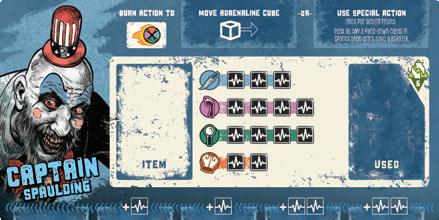






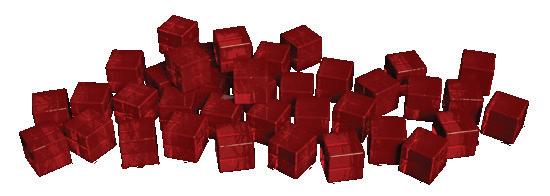



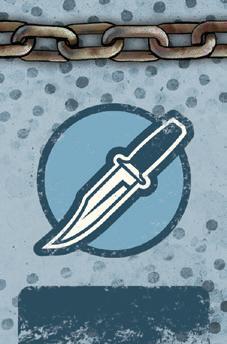
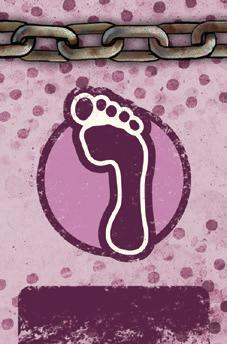
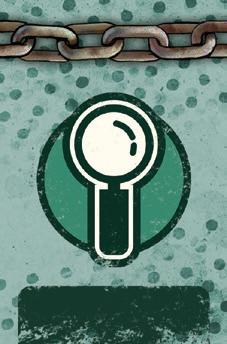
difficulty and Player count
Beginner Mode: Do not use Lt. Wydell.
Normal Mode: A game is won when the Blood Meter marker reaches the end of the track before the end of the 4th Action Round.
Nightmare Mode: For an extra challenge, the Blood Meter marker must reach the end of the Nightmare track before the end of the 4th Action Round.
One side of the Game board is for 1 or 3 players.
- When you are setting up for a 1 player game, choose any 3 Firefly characters to control simultaneously.



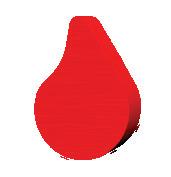



The other side of the Game board is for 2 0r 4 players.
- For 2 player games, have each player choose any 2 Firefly characters.
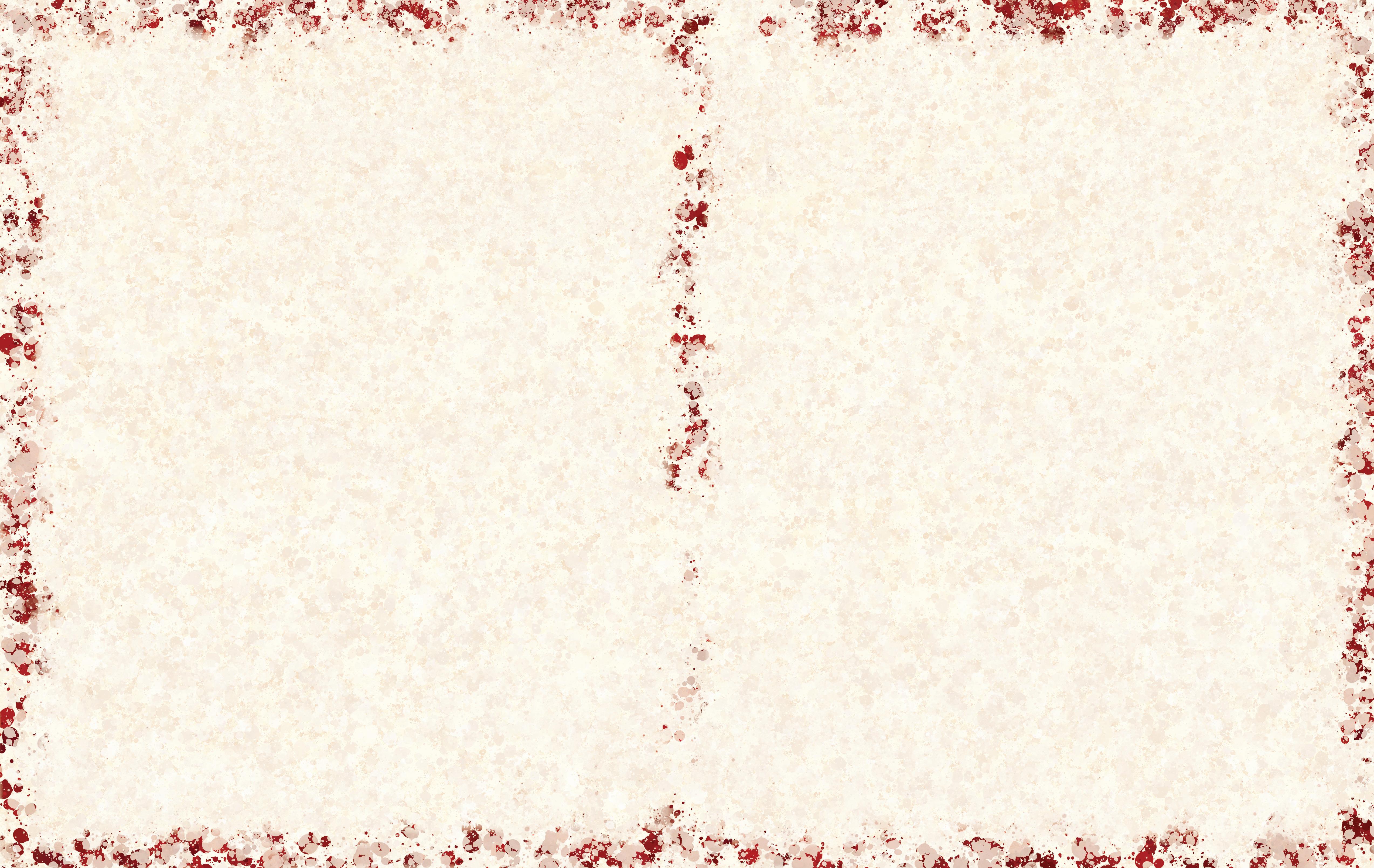

2
Kill Move Search components
capture
Search cards Game board 8 Player mats blood meter MarKEr
65
Lt. Wydell Standee
54 Adrenaline cubes 8 Character Standees 20 Run Cards 30 trophy Cards 16 Action Cards - 11 Victims - 12 Conditions - 14 Items - 10 Barriers - 10 Rabbits
Round MarKEr
Normal Mode Player Count Beginner Mode Nightmare Mode X
Setup
Prepare the Play Area
Place the Game board in the center of the table within easy reach of all players.

1 Place the Blood Meter marker on the to the left of the Blood Meter track on the Game board.
2 Place the Round marker on the first space of the Round track of the Game board, labeled Albert Fish
3 Place all the Corpse tokens in a pile next to the Game board.
4 Shuffle all the Trophy cards into a face-down Trophy deck and place it next to the Game board.
5 Shuffle all the Run cards into a face-down Run deck and place it next to the Game board.


Build the Seed and Search Decks
• Separate the Search cards into 5 piles by their types:


Fill up the Board
6 Using the 30-card Search deck, deal a stack of 3 cards face-down into each of the lettered room spaces (A-J) on the board.



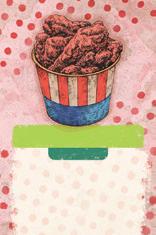






• From the Victim cards, set 2 Cheerleader cards aside. Then shuffle each pile individually.
• Using the separated piles of cards, build the Seed deck (10 cards) as follows:
- 2 Cheerleader Victim cards (set aside earlier)
- 2 Item cards
- 6 Barrier cards
• Then use the piles of cards to build the Search deck (30 cards) as follows:
- All 9 of the remaining Victim cards
- 5 Item cards
- 6 Condition cards
- All 10 Rabbit cards
• Return any Search cards that are left over from the separated piles to the game box, they will not be used this game. Shuffle both the Seed and Search decks individually, keeping them face-down.
7 Using the 10-card Seed deck, deal 1 card face-up into each of the lettered room spaces on the board In each room, if the face-up card is a...
a. Barrier or Item card, place that card face-up on top of the stack of 3 face-down Search cards. These face-up Items can be acquired by the normal Search action.
b. Victim card, place it next to the Search cards, then deal a Trophy card from the Trophy deck face-up on top of the stack of 3 face-down Search cards.
• Draw cards from the top of the Run deck until you reveal one that indicates a lettered space for Lt. Wydell. Place his standee in the matching lettered room space, then return the drawn cards to the Run deck and shuffle it.
Note: If this is a beginner game, return the Lt. Wydell standee to the box. He will not be used for the game.
3
VIctim bill Hudley 3 Item Fried ChicKen 1 2 1 broKen leG -1 -2 barrier Use 2 to remove Run Rabbit Run! Run Rabbit Run! barrier Use2 toremove 1 7 6 2 3 4 5
Victim Item Condition Barrier Rabbit
Get the Players Ready
• Have each player choose a Firefly character mat, returning any unused characters to the game box. Each player should fill all the spaces on their mat with Adrenaline cubes, then return any leftover cubes to the game box as well.

• Give each player the matching Character Standee and Initiative Marker for their characters, which they place next to their player mats.
• Give each player an identical set of 4 Action cards (Move, Search, Kill, and Capture), to be placed with the non-burned side up in the leftmost 4 slots beneath their Character mat (see “Character setup” below).
• All players should discuss which Actions they plan to take during the first round and rearrange the order of the Action cards beneath their player mat
Character Setup

accordingly, from left to right. The leftmost action slot will be their first Action, the one to the right of it their second, and so on.
If this is your first game, have all players arrange their cards in the order Move > Search > Kill > Capture.
• Next, players should decide the Initiative order: this is the order they will take their turns during the first Action round. Each player should then place their Character’s Initiative token on the track at the top of the game board: the Character in the leftmost slot will take the first turn, the Character to the right of it will take the second turn, and so on.
• Finally, have each player place their Character standee in any lettered space (A-J) of their choice that does not contain a face-up Victim card or the Lt. Wydell Standee.
Each player will use their personal mat to program and execute their actions throughout the game.
Adrenaline cubes
Character standee & Initiative marker
Each player has a Character standee to track movement and an Initiative marker that will be placed on the Initiative track at the top left of the Main Board to track turn order.
Item card space
On the left side of the Character mat is a space for a single Item card: the card in this space will provide ongoing benefits for the player and can be swapped out for another in their hand during a Recovery Round


Action Chain
In the center of each Character mat is a set of 4 rows of spaces for Adrenaline cubes . To the right of these rows is a Used area where players will move their Adrenaline cubes when they spend them to take an action. Players start the game with all the spaces on their Character mats filled with Adrenaline cubes: the cubes in these spaces represent the energy your character has available to take each of the 4 action types (Move, Search, Kill, and Capture) and they move to the Used area at the right of their mat once they are spent.
Used space
The Used area also has a Recovery Value that indicates the amount of spent Adrenaline cubes you can retrieve and place back in their spaces during each Recovery Round

The bottom of each Character mat has a set of 5 card slots called your Action Chain. Each player has a set of the same 4 Action cards (Move, Search, Kill, and Capture) that match the rows on their Character mat. These cards occupy the spots in your Action Chain, with resolved cards exiting the chain and reentering on the right (See the Action Chain section on pg. 8).
4
Game Board
The House
The House contains the spaces which all characters (players, victims, and Lt. Wydell) will move through during the course of the game.


Players can not move through solid walls. Players can move through dotted lines freely.


At the top and bottom of the board are the Back Porch and Front Porch EXIT spaces, which have some special qualities since they are visible to the outside world.
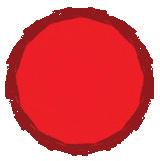
AThe 10 lettered spaces (A-J) are the rooms the players will search through to find victims, items, hazards, and other surprises.
The Tracks
The top of the board has several tracks that denote the progress of the Firefly family during the game.

At the top-left of the Main Board is the Initiative track, which sets and maintains the player turn order during the game.

At the top-center of the Main Board is the Blood Meter track. The Players work together to reach the end of this track in order to win the game.

Finally, at the top-right of the Main Board is the Round Track, with “attraction” spaces representing the 4 Action Rounds of the game and 3 Recovery Round spaces in between them. Once the 4 Action Rounds are over, the Ruggsville Sheriff ’s Department reinforcements arrive at the House and the players lose!

Search Cards
Victim Cards
Killing or capturing victims are the 2 ways the Fireflys will increase their Blood Meter during the game. Victims have a single value in their bottom right corner: their Strength . Most Victims will be hidden on the board for the players to find, but a small number will begin the game already revealed. Sometimes a Victim will be captured, and the card will go into the Action Chain on a character's mat, increasing future action costs.
Item Cards






Condition Cards
Players will also accumulate various Conditions throughout the House, which include injuries, confusion, or other hazards. Acquiring these cards slows your character down and temporarily makes it harder to take certain actions.
Barrier Cards
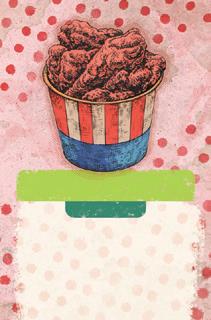
Items are another type of card players can find throughout the House. These provide ongoing boosts to specific actions when equipped on your Character mat, and may also provide additional during Recovery Rounds. A few Item cards will already be revealed on the board at the beginning of the game.







Barrier cards represent furniture shoved up against doors, lights that have been turned off, and other impediments that prevent the players from using a Search Action until they are cleared. Several Barriers will start on the board at the beginning of the game, but they can be removed by certain player actions.
Rabbit Cards
Hidden amongst victims, items, and conditions on the board are Rabbit cards. When these cards are revealed, a card is immediately drawn from the Run deck and will cause non-player characters to move!

5
Exit Exit
Back
COMPONENtS IN DEtAIL
Front Porch
Porch
Initiative
track Blood Meter track Round track
VIctim bill Hudley 3 Item Fried ChicKen 1 2 1 broKen leG -1 -2 barrier Use 2 to remove Run Rabbit Run! Run Rabbit Run!
Run Cards
Whenever a Victim needs to Run (see Running on pg. 13), the players will draw a Run card and activate all the categories of characters listed on it one at a time from top to bottom.
Trophy Cards





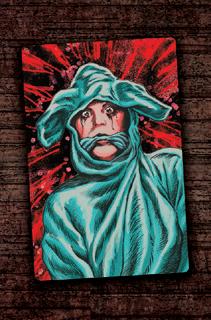




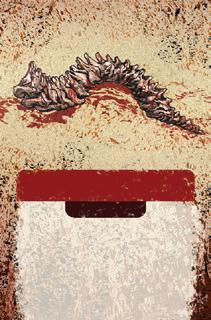


Corpse Tokens
In addition to drawing Trophy cards, players who kill a victim also get to place a Corpse token on top of any available corpse spot on the board. Corpses terrify Victims and slow them down when moving, but have no effect on Lt. Wydell.
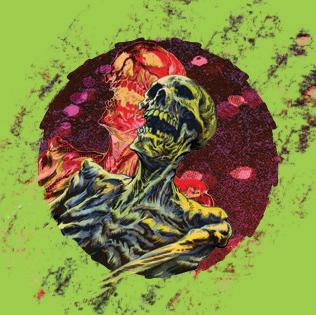

When a victim is killed, the player who dealt the final blow gets to dismember the corpse! They immediately draw a number of Trophy cards equal to the victim’s and add them to their hand. Each Trophy provides a one-time boost to one or more actions and/or during Recovery Rounds

Game Flow
Action Rounds
The majority of the game will take place over the course of 4 Action Rounds, where players will hunt down Victims and increase their Blood Meter to win the game. An Action Round has 4 steps that take place in the following order:
1. Take Player Turns
Players take their turns in the order of the tokens currently reflected on the Initiative track, starting from the leftmost space marked with a symbol.

When a player finishes their turn, they move their marker to the end of the track and slide the others forward in a “loop” . The Fireflys work together to determine the order of the Initiative track at the beginning of the game as well as during each Recovery Round.



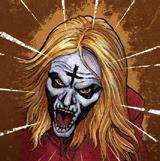

Lt. Wydell Standee
Lt. Wydell is represented by a standee that moves around the board according to the lettered spaces on Run Cards. When Wydell enters a space, several different troublesome effects may occur and players may only take Move Actions in his current location.


On a player’s turn, they must take at least one action if possible and may complete as many as they like before moving their Initiative marker to the end of the track and passing their turn to the next player.
Players may move through the Initiative order as many times as they like during an Action Round provided they can still afford to take actions with the Action cards and Adrenaline cubes on their Character mats.
When a player cannot or no longer wants to take any more Actions during the round, they announce that they are passing their turn and remove their Initiative token from the track. Players who pass may no longer take Actions during the current round.
All player information is considered public and players should feel free to share knowledge amongst each other as much as possible as they take and plan their turns.
2. Check for Game End
An Action Round is over when all the players have passed their turns. If this was the final Action Round and the Firefly family hasn’t yet filled their Blood Meter, the game ends and all the players lose!
6
A Exit 2 3 4
2
trophy Spine
3. Check for Running Victims
If this is not the final round, once the last player has passed, first check to see if any Victim cards remain face-up on the board. If so, draw the top card of the Run deck and resolve it immediately (see Running section on pg. 13).
4. Advance the Round Tracker
Finally, advance the Round marker on the Round track to the next space marked with a symbol and start a new Recovery Round.
Recovery Rounds



After each of the first 3 Action Rounds of the game, a Recovery Round occurs. This is where the Fireflys have a chance to recoup the energy they spent taking actions and heal from any mishaps. A Recovery Round has 5 steps that all players take simultaneously in the following order:
1. Swap Equipped Items
Each player can, if they choose, swap an Item card in the space on their Character mat for one from their hand.
2. Remove Conditions
Each player removes any Condition cards they accumulated in their Action Chain from the preceding Action round and discards them back to the box.

3. Retrieve Adrenaline Cubes

Each player adds up all the symbols in their player area, including:

• The Recovery Value printed at the top of the Used section of their Character mat

• Any symbols on the Item card currently equipped on their Character mat (if any)

• Any benefits from Trophy cards they wish to use from their hand, discarding the Trophy card back to the box after use.
• Players then retrieve this total number of Adrenaline cubes from their Used area, adding them back to any open spaces on their Character mat they choose.
Players may not rearrange any of the cubes left on their Character mat from the previous round: they may only add recovered cubes to empty spaces.
4. Reset Action Chain and Initiative Track
Working as a team, players should discuss what they plan to do during the next Action Round and the order in which they should occur.
Each player retrieves any Action cards they Burned (see Burning Action Cards on pg. 9) during the previous Action Round, flipping them back to their normal side. They then collect all 4 of their Action cards along with any other cards in their chain (including captured Victims) and rearrange them however they choose for the upcoming round.
If a player still has a captured Victim from the previous round, it must go into the first space in their Action Chain.
After players have discussed and arranged their upcoming plans using their Character mats, they should decide on a new order for the Initiative Track and arrange their markers on it accordingly.
5. Advance the Round Tracker
When all players have completed the above steps, advance the Round marker on the Round track to the next space (labeled with the name of a killer) and begin a new Action Round.
7
tAKING ACtIONS
The Action Chain
Your Action Chain is a queue of cards at the bottom of your player board. After resolving an Action card, it is ejected from the chain, then reenters your chain on the right side. All cards then slide to the left to fill in any empty spaces. You may take an action from anywhere in your chain. However, above each of the 4 rightmost slots in your chain is an additional cost that must be paid to use an action on the card currently in that slot.



During the game, other cards may also be added to your chain besides your 4 Action cards. These will always enter your chain on the right. If there is no open slot available for the card to be added, you must remove an Action card of your choice and slide the remaining cards to the left. Set the removed card next to your Character mat and flip it to its side -- you may not take this action for the rest of the Action Round, but will be able to retrieve it during the next Recovery Round.
Non-action cards in your chain do not resolve like Action cards and do not “cycle”. If they reach the left side of the chain when cycling cards, they simply stay there until they are removed in other ways.
Spending Adrenaline Cubes
All player actions are resolved the same way:
1 Choose an Action card anywhere in your chain to resolve.

2. Spend any number of from the matching row on your Character mat, moving them to your Used area.
3. Resolve the action based on the number of you spent.

4. Remove the chosen Action card from your chain, sliding all other cards to the left and placing the removed card in the first empty slot on the right
EXAMPLE
Using Action cards and Adrenaline cubes: Otis has decided to take a Kill action and moves 3 cubes from the corresponding row on his Character mat to the Used area on the right. He may now Kill a Victim with of 3 or less, or Destroy a Barrier of the same value. Once he is finished, he will cycle his Action cards by moving the Kill card to the right and sliding the others to the left.





Additional Action Chain Costs:

Next, Otis will take a Move action, but this card is in a slot with an extra cost. He spends 3 total cubes and moves his pawn 2 spaces on the main game board. He then removes the Move card from his chain, slides the others down, and adds it to the end.



8
Burning Action Cards
Action cards in your chain also have an important secondary use: at any time during an Action Round, even on another player’s turn, you may choose to Burn an Action card. Any other action currently in progress (such as revealing and resolving Search cards) must be completed before you may trigger this effect.


Whenever you burn an Action card, you MAY choose one of the following:

1. Immediately move 1 cube from a row on your Character mat to any other row of your choice.
OR
2. Use the Special Action printed on your Character mat.
To Burn an Action card, first remove one Action card of your choice from anywhere in your chain, sliding the remaining cards down to the left.

Flip the removed card to its side and place it sideways in one of the slots at the top right of your player board for the benefit you have chosen.
You may not use the Action card you just Burned for the rest of the current Action Round, but will be able to retrieve it during the next Recovery Round.

You may burn an Action card even if all slots on your Character mat are completely full, but without the benefit of moving cubes between rows when doing so.

Item and Trophy Cards
Over the course of the game, you may accumulate multiple Item and Trophy cards to form a combined hand of up to 5 cards. If at any point during an Action Round you have more than 5 total cards in your hand, you must immediately discard down to 5 Item cards in your hand have no effect until they are equipped on your Character mat, while Trophy cards are always played from your hand.
Using Item Cards
Players may have 1 Item card equipped on their player board at a time, which provides ongoing boosts to certain types of actions. Whenever you would spend cubes to take that type of action, you may use these boosts to increase the strength of your


action as though you had spent additional cubes. However, you must always spend at least 1 from your Character mat each time you take an action.
If you reveal or pick up an Item card and do not have one equipped on your Character mat, you may immediately equip it. However, if you already have 1 equipped, you may only change your equipped Item during a Recovery Round.
Using Trophy Cards
Players may also play Trophy cards from their hand that provide single-use action boosts. You may use as many Trophy cards as you like to boost the action you are resolving (including in combination with Item cards), but you must immediately discard each Trophy card used back to the box. You may only use trophy cards in your hand on your own turn.
EXAMPLE
Using Item and Trophy cards: Otis wants to take a Search action with a value of 3, but he only has 2 cubes to spend from the corresponding row.


Luckily, he has a “Rib Cage” Trophy card that can boost his 2 to 4 when he takes the action, then gets discarded.
Alternatively, he could instead use the “Tiny’s Bowl” Item card he has equipped, which will boost his 2 to 3 but remain on his Character mat.
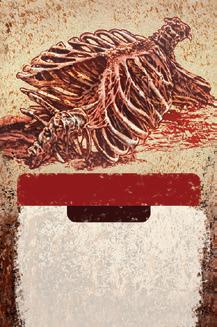

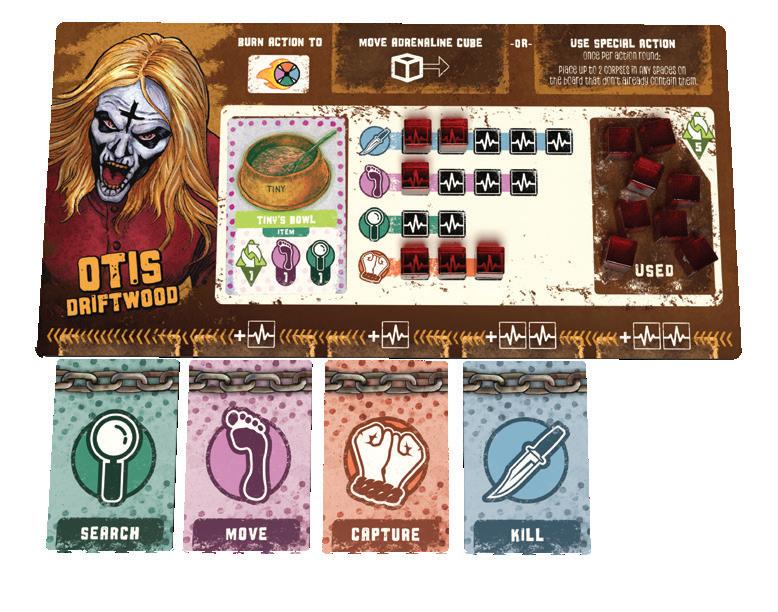
Trading with Other Players
If you share the same space with another player, either of you may freely give the other any amount of Item cards or Trophy cards from your hand. This does not require taking an action or spending cubes.

9
trophy Rib CaGe 2
ACtION tYPES
Move Action

To perform a Move action, first spend any amount of from the row on your Character mat by moving them to your Used area. Then move your Character standee an equal number of spaces in the House orthogonally.


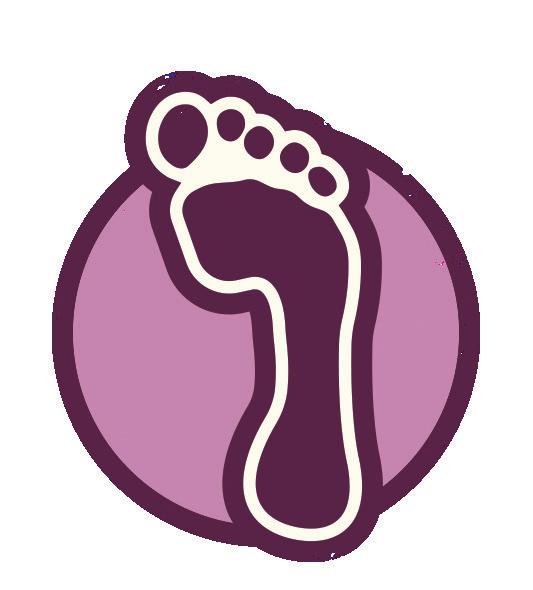
The on the game board are walls: you may not move through them, but you may move between spaces connected by a dotted line . You may also move off the board from either the Front Porch or Back Porch spaces only (see Capture Action on pg. 12). You may stop your Character standee before you have moved the full number of spaces indicated by your spent cubes, but any unused cubes will remain in your Used area until the next Recovery Round. Whenever your Character moves into a space with a face up Item card, you may immediately add it to your hand, discarding down to 5 cards afterward if necessary.



Kill Action

To perform a Kill action, first spend any amount of cubes from the row on your Character mat by moving them to your Used area. You may then either Kill a Victim or Destroy a Barrier equal to or less than the number of cubes spent.
Killing Victims


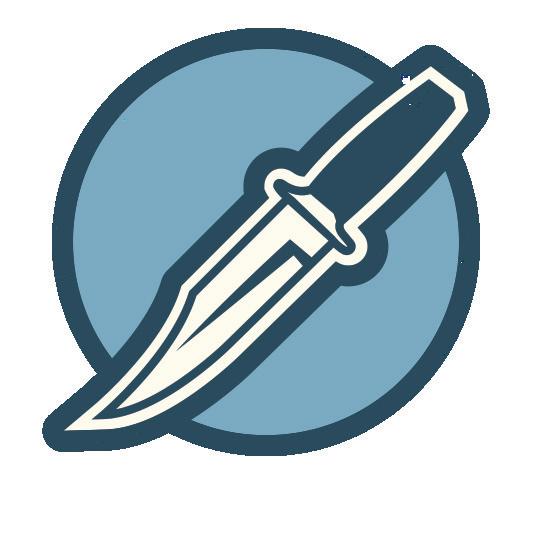



If you spent a number of equal to or greater than the value of a Victim in your space, you have killed them. When you Kill a Victim, take the following steps:
1 Discard the Victim card from the board.
2. Advance the Blood Meter marker 1 space.

3 Draw a number of Trophy cards equal to the of the killed Victim and add them to your hand, discarding down to 5 cards afterward if necessary.
4. Place a Corpse on any Corpse token space inside the house that doesn’t already have one.
Destroying Barriers


Some Barrier cards have a symbol and value on them. To remove a Barrier card in a space with your Character standee, spend equal to or greater than its value and immediately remove it from the board.
EXAMPLE
Taking a Move Action:


Otis spends 2 cubes from the row of his Character mat, using “Tiny’s Bowl” to boost this value to 3. He then moves his player pawn 3 spaces in the House, noting that the bordered walls will force him to use the stairs.

EXAMPLE
Taking a Kill Action:


Otis spends 2 cubes from the row of his Character mat to Kill the “Cheerleader” in his space. He discards her Victim card, increases the Blood Meter by 1, draws 2 Trophy cards (because of the Cheerleader’s 2 ), and places a Corpse token on the board.




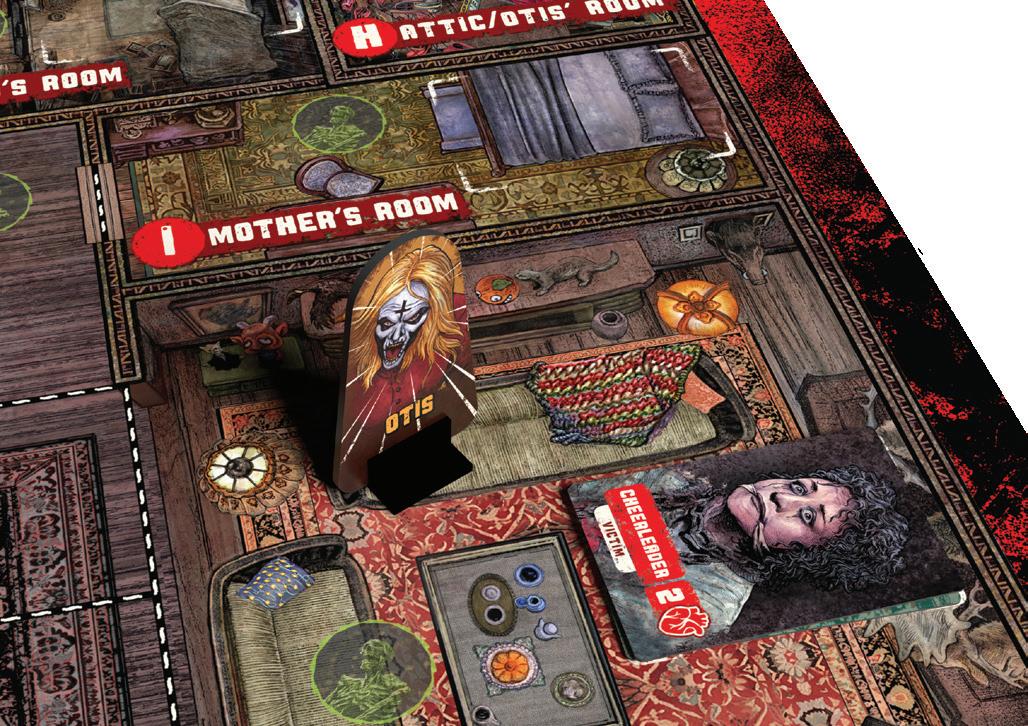

10
1 2 3 +
Search Action





To perform a Search action, first spend any amount of cubes from the row on your Character mat by moving them to your Used area. Then, one at a time, reveal and resolve face down Search cards in your space equal to the number of cubes spent. You must fully resolve each Search card you draw before moving onto the next, and you must resolve the total number of cards you have chosen with your cubes!

For example, if you have spent 3 to Search, you may not stop revealing cards after resolving only 2. Revealing and resolving the 3rd card is mandatory!
If you draw and resolve the last remaining search card in the space with your Character standee, your Search action is considered resolved and any unused cubes you spent will remain in your Used area until the next Recovery Round.
Rooms with Barriers

Resolving Item Cards
When you reveal an Item card, you may add it to your hand or — if you do not already have an Item equipped — immediately equip it by adding it to the Item space on your Character mat. You may also choose to leave the revealed Item in the current space (next to the Search cards there) where another player may pick it up later merely by entering the space.
Resolving Condition Cards









If your Character standee is in a room that contains a Barrier card, you may not perform a Search action. However, once the Barrier is removed, you may immediately perform Search actions in the room as normal.
Resolving Victim Cards
When you reveal a Victim card, immediately draw a Run card and resolve it from top to bottom (see Running on pg. 13).
EXAMPLE
Taking a Search Action:


Otis spends 2 cubes from the row of his Character mat to search “Mother’s Room”. He has now committed to revealing and resolving 2 face down cards in his space. The first is an Item, “Tiny’s Bowl” that he decides to equip on his Character mat. The second is a Rabbit card, which he will need to resolve immediately.
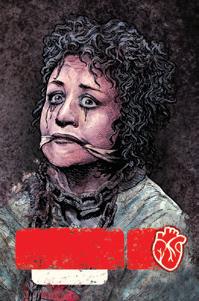
When you reveal a Condition card, first remove the corresponding number of from your board as indicated by the listed action symbols. After removing cubes, add the Condition card to the first open spot on the right of your chain. If all 5 of the slots in your chain are full, first remove an Action card of your choice, setting it aside and flipping it to its side, and slide the remaining cards to the left.
Resolving Rabbit Cards


When you reveal a Rabbit card, it’s time for all the non-player characters on the board to activate! Discard the card, then draw the top card of the Run Deck. From top to bottom, resolve the Run card by moving every type of Victim — and possibly Lt. Wydell — according to the symbols on the card (see Resolving Run Cards on pg. 13).





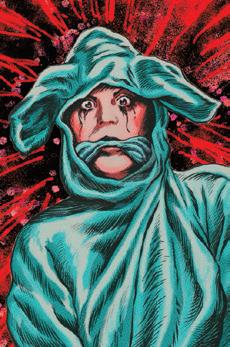

11
barrier Use 2 to remove Run Rabbit Run! Run Rabbit Run! VIctim cheerleader 2 Item Fried ChicKen 1 2 1 broKen leG -1 -2 Run Rabbit Run! Run Rabbit Run! tiny’sItembowl 1 1 1
Capture Action

To perform an Capture action, first spend any amount of cubes from the row on your Character mat by moving them to your Used area. You may then either Capture a Victim or Evade a Barrier with a value equal to or less than the number of cubes spent.




Capturing Victims


Note: players with a captured Victim do not have to leave the board with them immediately. They can even choose to keep them in their Action chain between rounds, but they will continue to make actions more expensive by taking up space.
Evading Barriers



Some Barrier cards have a symbol and value on them. To remove these Barriers on a space with your Character standee, spend equal to or greater than its value and immediately remove the Barrier from the board.
EXAMPLE

If you spent a number of greater than or equal to the value of a Victim in your space, and you do not already have a Captured victim, you have captured them as a specimen for Doctor Satan! When a Victim is captured, add the Victim card to the first open slot on the right of your Action Chain. If all 5 of the slots in your chain are full, remove an Action card of your choice, setting it aside and flipping it to its side, and slide the remaining cards to the left.
Capturing a Victim does not immediately increase the Blood Meter!
In order to score a captured Victim in their chain, a player must successfully move off the board from either the Front Exit or Back Exit Porch spaces. When this happens:


1 Immediately remove the Victim card from your Action Chain and discard it, sliding down the other cards if necessary.
2. Increase the Blood Meter by a number of spaces equal to the Victim’s

3. Place your Character standee back onto the main game board in either the Front or Back Porch space (it does not need to be the same space you used to leave the board)
Remember: a player may have only have 1 captured Victim at a time!
Special Actions




Taking a Capture Action: Otis is in the Living room. He spends 3 cubes from the row of his Character mat and cycles his Action card to Capture Don Willis. Next, he moves Don’s Victim card to the rightmost open spot at the end of his Action Chain. Later, once Otis has successfully moved off the board with Don in his chain, he will discard the Victim card and advance the Blood Meter by 3 spaces according to Don’s Strength .



Each player also has a Special Action printed at the top of their Character mat. The “ Burn Action” symbol means you may Burn any Action card in your chain (see Burning Action Cards pg.9) to resolve the effect of your Special Action. You may trigger your Special Action at any time, even on another player’s turn, but must first complete any other actions currently in progress. Players will retrieve any Action cards they Burned during the recovery round, adding them back into their Action Chain.
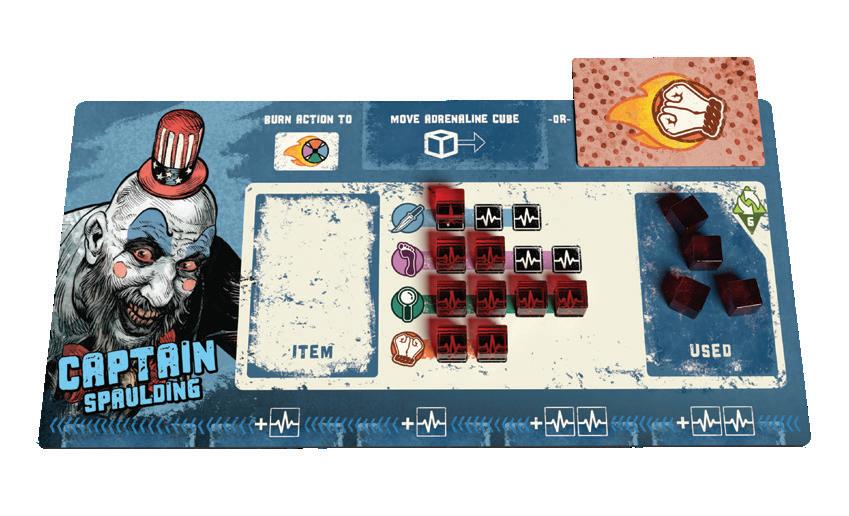
12
RunninG
In 3 specific cases, the non-player characters on the board will Run, moving around on the main game board in various directions. This happens when:
1. A new Victim is revealed during a Search action.
2. A Rabbit card is drawn during a Search action.
3. 1 or more Victim cards remain on the board at the end of an Action Round.
In all 3 of these cases, the players draw the top card of the Run deck and immediately resolve EVERY symbol on it from top to bottom.
Resolving Run Cards
Each run card lists all the different types of nonplayer characters. Each time a Run card is drawn, activate all of the types of any characters in order from top to bottom:

First, activate Victims with 4 (moving, hiding, or escaping as needed)

Second, activate Victims with 3 . (moving, hiding, or escaping as needed)

Third, activate Victims with 2 . (moving, hiding, or escaping as needed)
Finally, if you are playing in Normal or Nightmare mode, activate Lt. Wydell .

If a type of character on a Run card has no symbol to the right of it, nothing happens for these characters and they remain in their current spaces.
EXAMPLE
Running:
A run card has been drawn that will cause all characters with 4 to Run toward the Back Porch space.

Jerry Goldsmith’s card will move from its current space along the shortest path, 1 space for each of his value.










He has almost escaped the House!
Each character type will have a symbol to its right that indicates how it will activate:

Front Porch: the character will move a number of spaces equal to its along the shortest path toward the Front Porch space, escaping off the board if possible.


Back Porch: the character will move a number of spaces equal to its along the shortest path toward the Back Porch space, escaping off the board if possible.


Hide: the character will move a number of spaces equal to its along the shortest path to the nearest lettered room space with face down cards, Hiding if possible.


Lettered Space: Lt. Wydell will move along the shortest path toward the indicated lettered space, stopping when he has entered it (see Moving Lt. Wydell on pg. 15).
Escaping
The ultimate goal of all Victims on the board is to escape the House and the clutches of the Firefly family! When a running Victim’s movement takes it off the board via the Front or Back Porch spaces, immediately remove their card from the board and set it to the side of the play area. If this was the 3rd escaped Victim, the game is over and all players lose!

13
Exit Exit A A Exit 2 3 4 1 2 3 4
Hiding

Instead of running toward the Front Exit or Back Exit Porch, Victims may instead try to Hide by entering the nearest lettered room that contains face down Search cards.


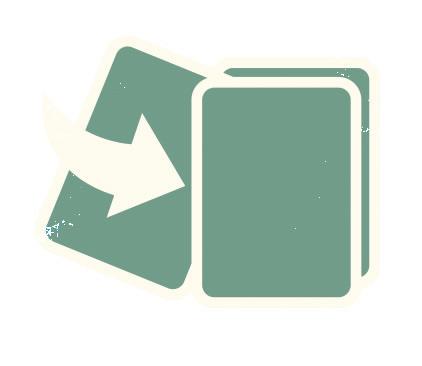

If a Victim has a on the Run card next to their type, first move them according to their value, following the shortest path to a room with unrevealed (face-down) Search cards. If the Victim successfully reaches the targeted room, shuffle their card into the other face-down Search cards in the room. This Victim is now hidden and you will need to re-search the room in order to reveal them!

Corpses
Whenever a Victim is killed, the player who did so places a Corpse token in the House. These tokens function like traps as a way to slow down running Victims, terrifying and distracting them. These tokens are placed with their face-up (“active”) side showing, but will be triggered and flipped to their face-down (“inactive”) side by other characters.

If there are multiple rooms a Victim could move toward in order to Hide, choose the one that is farthest away from any Character standees. If there are still multiple options, the players collectively choose the targeted room.
If there are no lettered rooms with face-down cards left on the board, a Victim attempting to Hide will simply move toward the nearest lettered room.
A Victim does NOT need to use all of its movement value before hiding, and may in fact use only part of it before they reach a room with face-down Search card.
EXAMPLE




Hiding and Corpse tokens: A Run card has been drawn that will cause all characters with 4 to Hide. Jerry Goldsmith's card will move from his current space along the shortest path to the nearest room with at least 1 face down Search card, in this case the “Kitchen”. He must stop at the Corpse token in the hall space to flip it, which uses one of his total movement. When he reaches the “Kitchen”, Jerry’s Victim card will be shuffled into the stack of cards in his space: he is now Hiding and players much re-search the room to reveal him again!







Tokens can be placed on any of the matching spots on the Game board that don’t already have one and there can only be 1 Corpse placed on each spot during the game. Active Corpses will take affect any time a Victim enters the space while running.
When a running Victim enters a space with an active Corpse token and they have movement left, they must spend one of their total movement value to flip it to its inactive side before they can continue. They’ve encountered a gruesome sight and must recover! After flipping the Corpse token, the Victim continues any of their remaining movement as normal. Inactive Corpse tokens do not have any effect on running Victims. Lt. Wydell is never slowed down by Corpse tokens, either active or inactive.
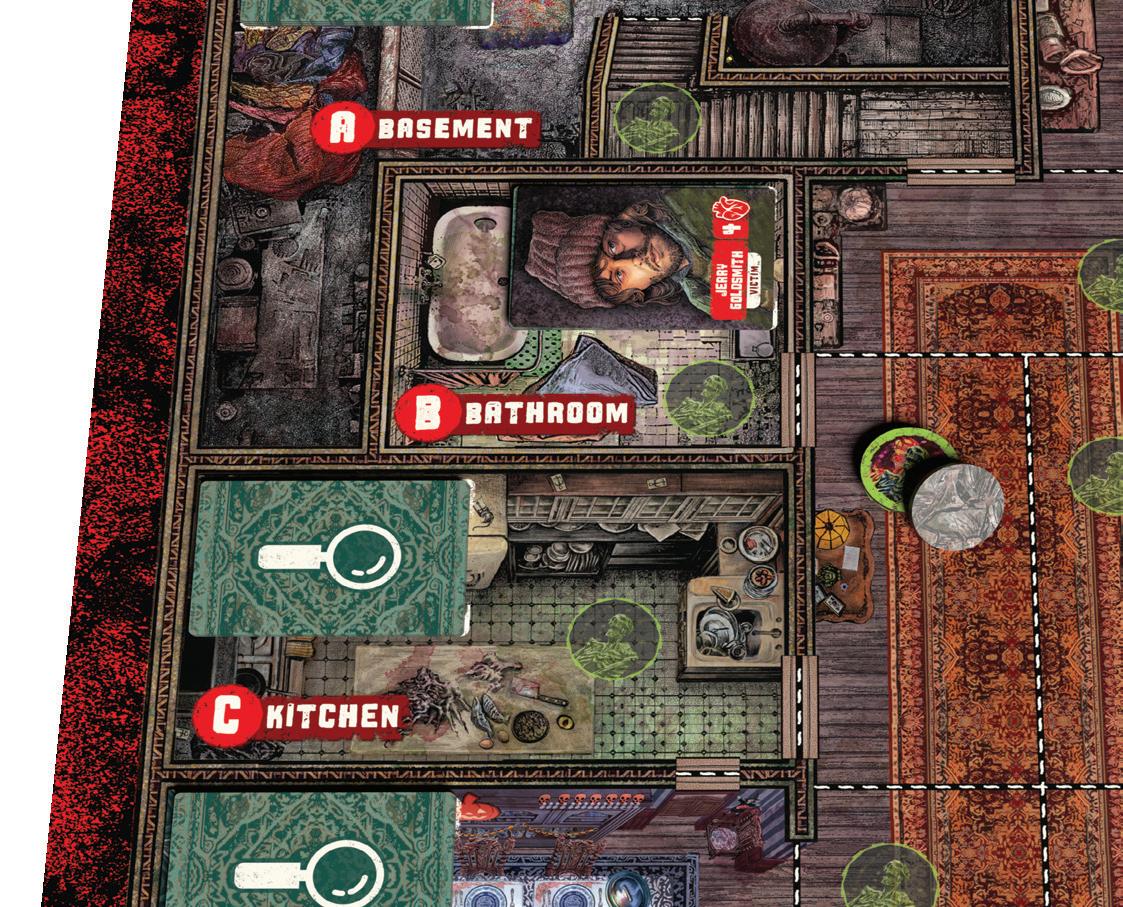
14
b 2 3 4 Active Inactive 1 2 3
Lieutenant WYDELL
Moving Lt. Wydell
Any time a Run card is drawn, it may contain a lettered space next to the symbol. If it does, the Lt. Wydell standee will move along the shortest path toward the indicated lettered space, stopping only when he has entered it.









If there are multiple options for the shortest path to the targeted space, the players choose which one Lt. Wydell takes.
Limiting Player Actions
Players currently sharing a space with the Lt. Wydell standee may only take Move Actions: they cannot risk getting caught in the middle of misdeeds!

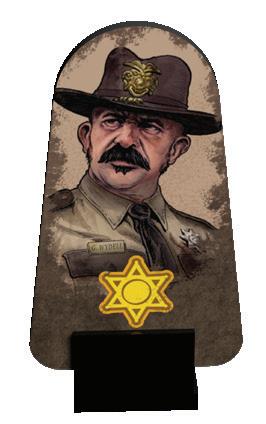
If any effect causes Lt. Wydell to leave a player’s space, they may immediately take actions as normal. Similarly, if an effect causes Lt. Wydell to enter a player’s space in the middle of an action, they must stop resolving it immediately (even if they have not completed it yet).
Lt. Wydell Effects
There are several effects that may trigger when Lt. Wydell moves across the board, and multiple (even all) effects can occur while resolving his movement. These effects are:
ENDING tHE GAME
Winning
As soon as the Firefly family’s Blood Meter marker reaches the final space of the track, all players immediately win the game together! They have satisfied Doctor Satan and kept enough of their activities secret to avoid suspicion.
Note: If playing the beginner game, you will not play with Lt. Wydell and can skip these rules, coming back to them when you’re ready for a tougher challenge.
• If Lt. Wydell shares the same space with a Victim: the Victim immediately escapes (see Escaping section on pg. 13). This can occur both when Lt. Wydell enters a space with a Victim as well as when Victims move into his space. When this happens, remove the Victim’s card from the board and place it to the side. If this was the third Victim to escape the House, the game ends immediately and the players lose!
• If Lt. Wydell moves through or ends his movement in a space with a player who has a captured Victim in their chain: the Victim immediately escapes (see Escaping section on pg. 13). Remove the Victim’s card from the board and place it to the side, once again ending the game if it was the third Victim to escape.
• If Lt. Wydell moves through or ends his movement on a space with a Corpse token: flip the token to its inactive side, but continue the rest of his movement as normal (he is not affected).
• If Lt. Wydell ends his movement on a space with a Barrier card: immediately discard it. Players may now take Actions in this room once Lt. Wydell has left.
• If Lt. Wydell ends his movement on a space with no victims or barriers: immediately reveal the top Search card in that space. Resolve it as normal, but discard any Condition cards revealed this way. If there are no remaining Search cards in Lt. Wydell’s space, nothing happens.

Losing
If at any point during the 4th Action Round all players have passed or there are no remaining legal actions available that would increase the Blood Meter, the game is over and all the players lose! Police reinforcements have arrived with too much evidence in plain sight and the family’s days of freedom are numbered.
The players can also lose immediately if a 3rd Victim escapes the game board and/or is rescued by Lt. Wydell: too many people have seen too much and are let loose to tell their macabre story!

15
b 2 3 4
QUICK reference Guide
Action Round Sequence
1. Take player actions
2. Check for game end
3. Check for running victims
4. Advance the Round marker
Recovery Round Sequence
1. Swap equipped Item card

Player Actions



Move – Spend to move your Character standee up to that many spaces on the board.

Kill – Spend to Kill a Victim or Destroy a Barrier in your space.

Search – Spend to reveal/resolve that many Search cards in your space.

2. Retrieve cubes
3. Reset Action Chain and Initiative Track
4. Advance the Round marker


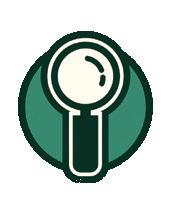
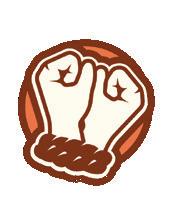

CREDITS
GAME DESIGN: Nick Badagliacca
ILLUSTRATION: Dug Nation
GAME PRODUCER: Chris Zephro
GRAPHIC DESIGN: Jody Henning
PROJECT MANAGEMENT: Andy Van Zandt



Capture – Spend to Capture a Victim or Evade a Barrier in your space.


Special Action – Immediately burn a card to resolve your Character’s special action (even on another player’s turn)
Symbol GUIDE










PLAYTESTERS: Luke Abbott, Eize Basa, Bronwyn Ciccone, Grayson Davis, Sagar Desai, Brian Doyle, Chris Geiger, Collette Harrison, Savannah Hayes, Wyatt Hull, Shane Ivins, Frank Kaehler, Kurt’s Krazies, Jess Morrissette, Mel Nash, Larry Plageman, Arlo Plageman, Joe Stoken, Shannon Sullivan, Andy Van Zandt, Ben Vigeant, Ada Weyland, Lauren Zephro, Chris Zephro, Scott Zumwalt.
1000 Corpses, LC TM & © 2024 Global Merchandising Services Ltd. Al rights reserved.
16
Move Action Front Porch Remove Card Burn Action Kill Action Back Porch Recovery Search Action Hide Strength Capture Action Room Adrenaline Cube Any Action Lt. Wydell Exit Exit A















































































































































































